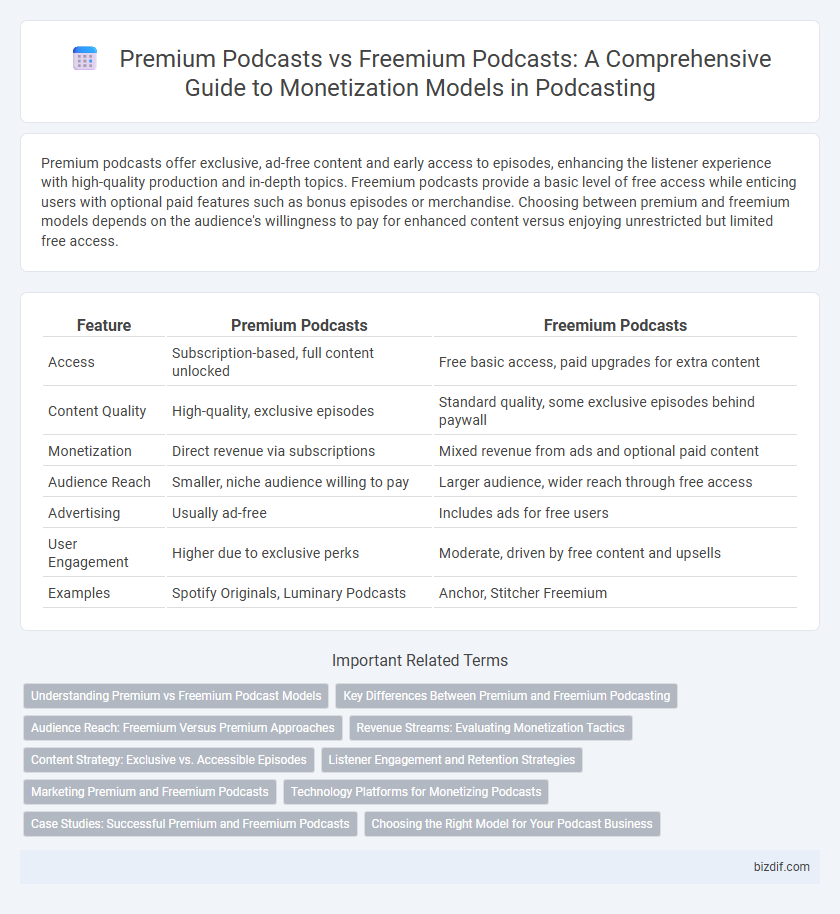Premium podcasts offer exclusive, ad-free content and early access to episodes, enhancing the listener experience with high-quality production and in-depth topics. Freemium podcasts provide a basic level of free access while enticing users with optional paid features such as bonus episodes or merchandise. Choosing between premium and freemium models depends on the audience's willingness to pay for enhanced content versus enjoying unrestricted but limited free access.
Table of Comparison
| Feature | Premium Podcasts | Freemium Podcasts |
|---|---|---|
| Access | Subscription-based, full content unlocked | Free basic access, paid upgrades for extra content |
| Content Quality | High-quality, exclusive episodes | Standard quality, some exclusive episodes behind paywall |
| Monetization | Direct revenue via subscriptions | Mixed revenue from ads and optional paid content |
| Audience Reach | Smaller, niche audience willing to pay | Larger audience, wider reach through free access |
| Advertising | Usually ad-free | Includes ads for free users |
| User Engagement | Higher due to exclusive perks | Moderate, driven by free content and upsells |
| Examples | Spotify Originals, Luminary Podcasts | Anchor, Stitcher Freemium |
Understanding Premium vs Freemium Podcast Models
Premium podcasts offer exclusive content behind a paywall, generating revenue directly from subscriber fees, often providing ad-free episodes, bonus material, and early access. Freemium podcasts combine free episodes with paid upgrades, such as ad-free listening or special series, attracting a wider audience while monetizing through optional subscriptions or micropayments. Understanding these models enables creators to balance audience reach and revenue, tailoring strategies to content value and listener preferences.
Key Differences Between Premium and Freemium Podcasting
Premium podcasts offer exclusive, ad-free content often requiring a subscription or one-time payment, delivering higher audio quality and specialized topics for dedicated listeners. Freemium podcasts provide free episodes with ads and limited access, while premium content is available via in-app purchases or memberships, balancing accessibility with monetization. Key differences revolve around content accessibility, revenue models, and listener engagement strategies, influencing production value and audience targeting.
Audience Reach: Freemium Versus Premium Approaches
Freemium podcasts attract a broader audience by offering free access to basic content while reserving advanced episodes or features for paying subscribers, thus maximizing reach and engagement. Premium podcasts limit access exclusively to paying members, resulting in smaller but more dedicated and potentially higher-quality listener bases. This trade-off between wider exposure and exclusive content defines the core audience strategy in podcasting monetization models.
Revenue Streams: Evaluating Monetization Tactics
Premium podcasts generate consistent revenue through subscription fees and exclusive content access, attracting loyal listeners willing to pay for ad-free experiences and bonus episodes. Freemium podcasts rely heavily on diverse monetization tactics such as advertising, sponsorships, and limited free content to maximize audience reach while encouraging upgrades to premium tiers. Analyzing listener engagement patterns and revenue diversification helps podcasters optimize income streams by balancing free accessibility with paid value propositions.
Content Strategy: Exclusive vs. Accessible Episodes
Premium podcasts offer exclusive episodes that provide in-depth content, targeted interviews, and behind-the-scenes insights unavailable to free listeners, driving subscriber loyalty and higher revenue. Freemium podcasts balance accessible episodes to attract a broad audience while reserving advanced or ad-free content for paying members, enhancing audience engagement without alienating casual listeners. Strategic content segmentation ensures audience growth through open access while maintaining monetization via exclusive material.
Listener Engagement and Retention Strategies
Premium podcasts enhance listener engagement by offering exclusive content, ad-free episodes, and early access, which fosters a sense of community and loyalty. Freemium podcasts attract a broad audience by providing free episodes while upselling premium features, utilizing teasers and bonus material to encourage conversion. Effective retention strategies include personalized content recommendations, interactive listener feedback channels, and consistent release schedules to maintain audience interest and commitment.
Marketing Premium and Freemium Podcasts
Marketing premium podcasts leverages exclusive content, targeted advertising, and subscription-driven models to attract dedicated listeners willing to pay for ad-free, high-quality episodes. Freemium podcasts use a hybrid approach by offering free content with optional paid features or bonus episodes, driving broader audience reach while monetizing through upgrades and sponsorships. Effective promotion of both types involves strategic use of social media, SEO-optimized show notes, and partnerships with influencers to maximize visibility and listener engagement.
Technology Platforms for Monetizing Podcasts
Premium podcasts leverage subscription-based platforms like Apple Podcasts Subscriptions, Spotify's Anchor Premium, and Patreon to generate consistent revenue through exclusive content access. Freemium podcasts utilize ad-supported platforms such as Spotify, Google Podcasts, and Stitcher to monetize via dynamic ad insertion and sponsorship deals while offering free content to attract a broad audience. Advanced analytics and programmatic advertising integrations on these technology platforms enable podcasters to optimize monetization strategies tailored to listener behavior and engagement metrics.
Case Studies: Successful Premium and Freemium Podcasts
Exclusive content drives subscriber loyalty in premium podcasts, as seen in "The Daily" by The New York Times, which leverages in-depth journalism to attract paying audiences. Spotify's "The Michelle Obama Podcast" exemplifies the freemium model by providing free episodes with optional ad-free premium tiers, maximizing reach while generating revenue through ads and subscriptions. Both models demonstrate strategic content delivery aligned with audience willingness to pay and consumption habits, crucial for sustained growth in podcast monetization.
Choosing the Right Model for Your Podcast Business
Premium podcasts offer exclusive, ad-free content behind a paywall, generating direct revenue through subscriptions or one-time purchases. Freemium podcasts combine free episodes with bonus content available for purchase, balancing audience growth and monetization. Evaluating audience size, engagement levels, and long-term revenue goals is essential for selecting the ideal model that maximizes profitability and listener loyalty.
Premium podcasts vs Freemium podcasts Infographic

 bizdif.com
bizdif.com